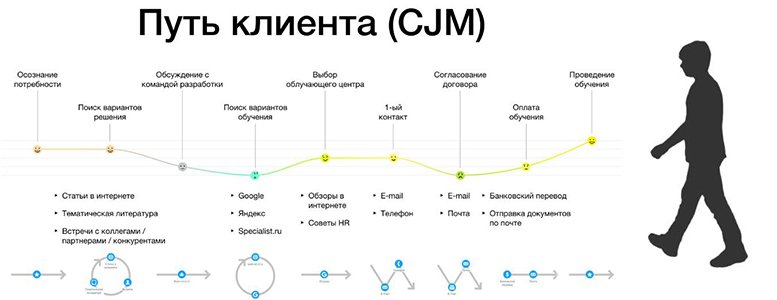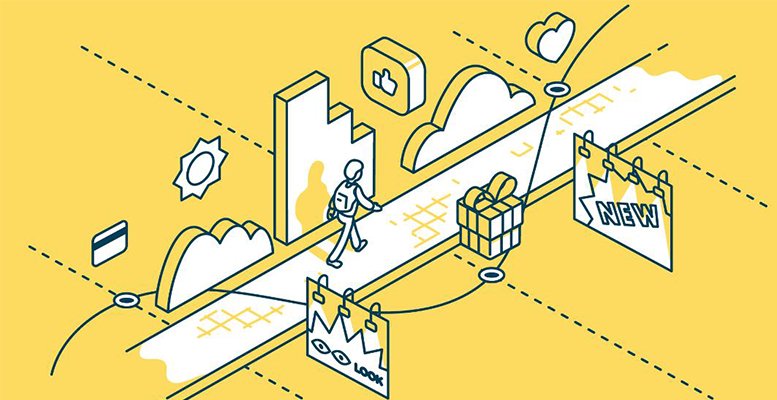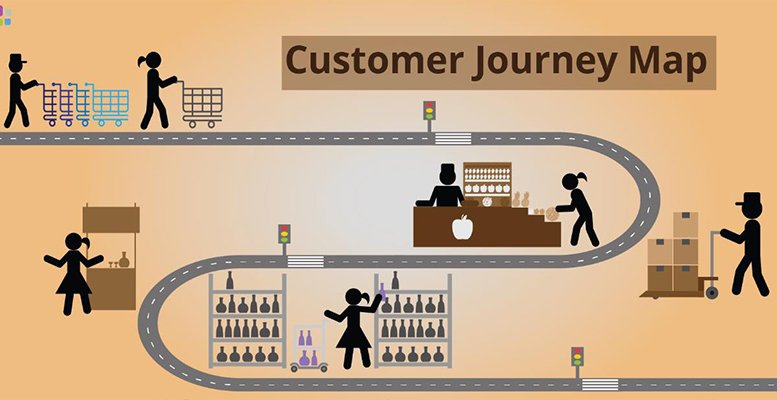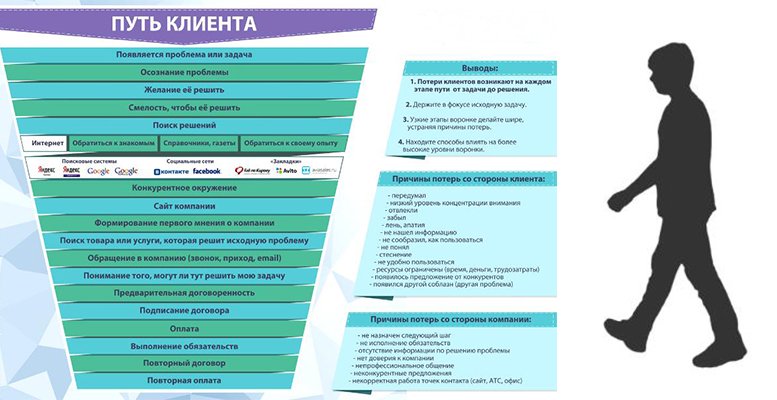Карта подорожей користувача – Customer Journey Map
Мова йде не про прості подорожі, які теж вимагають докладних карт, а про ті пересування, які виробляє покупець під час взаємодії з товаром. Customer Journey Map (CJM) – карта подорожі користувача, про яку знає не покупець, а уважний менеджер, реалізатор своїх товарів. Стежити за тим, як відбувається послідовність прийняття рішення про покупку, не тільки захоплююче, але і дуже корисно. Так можна зрозуміти, які етапи долає клієнт перед тим, як здійснити покупку.
Можливо, йому допомагає ваша реклама, на якій він бачить заклики до дії. У будь-якому випадку, щоб зрозуміти, як продавати більше, необхідно звертати увагу на процес, що відбувається у свідомості клієнтів.
Для чого потрібні карти подорожей користувачів
Такі карти можуть бути віртуальними, тобто складеними в мозку менеджера. Але краще, якщо вони будуть реальними, складеними на папері. Так набагато простіше відстежити всі етапи, пройдені відвідувачем до моменту безпосередньої покупки.
Карта допоможе вам зрозуміти, що клієнт відчуває на кожному з етапів. Як він взаємодіє з продуктом, що думає про нього. Така робота дозволить усунути можливі перешкоди на шляху до процесу оплати. Ви зможете удосконалити не тільки сам товар, а й спосіб його викладення, розширити види реклами.
CJM допомагає з’ясувати такі важливі питання, як:
- де саме клієнти знаходять інформацію про ваші товари;
- в яких місцях вони знаходять продукцію. Наприклад, знаходять її на сайті або приходять в магазини, замовляють через додаток;
- як реагує на товар ваша аудиторія;
- який вік ЦА;
- які заперечення виникають на шляху прийняття рішення про покупку;
- як реагують покупці на спосіб продажу;
- в яких випадках клієнти максимально задоволені;
- коли вони відчувають розчарування і т.д.
Всі ці моменти вносять в таблицю або складають графіки. Потім інформація аналізується, приймаються рішення про вдосконалення та виключення негативних моментів, виправлення помилок.
Карта допоможе менеджеру пройти шлях кожного клієнта на шляху взаємодії з товарами.
Відмінність карти CJM від воронки продажів
Варто зазначити, що карта покупця відрізняється від воронки продажів. Головна відмінність в тому, що воронка відображає бажані кроки покупця до покупки. А карта подорожі, указує на можливість альтернативних реальних рішень, які дійсно проходить клієнт. Вона показує всі його сумніви, коливання, питання, невдоволення, що виникають на шляху до покупки.
Воронка продажів – дорога клієнта, запланована менеджером.
Карта подорожі – реальний шлях кожного покупця.
Для кого підходять карти CJM
Такі карти особливо необхідні для середнього та малого бізнесу зі складними схемами продажів. Наприклад, їх варто складати тим компаніями, у яких діє стаціонарний магазин, інтернет-магазин, кур’єрська служба, є зовнішня реклама і реклама в інтернеті. Це вважається складною системою продажів.
Складати карту подорожі стоїть практично на всіх етапах:
- Під час впровадження самої ідеї бізнесу для зменшення можливих проблем.
- Коли продукція раптом перестала продаватися, і з’явилося багато негативних відгуків.
- Успішний спочатку бізнес став просідати, необхідні нові ідеї для його реанімації.
Навіть для великих компаній вкрай необхідно періодично складати карти подорожей окремих покупців, щоб зрозуміти, як утриматися на плаву, знайти підхід до своїх споживачів, збільшити продажі.
Що вказати в карті
Це може бути графік, малюнок, зображення, створене за допомогою фотографій, спеціальних редакторів. Тут важливо зберігати структуру, виділяючи етапи, які проходить кожен користувач. Серед них такі:
- Момент, під час якого клієнт вперше зустрічається з інформацією про ваш продукт. Наприклад, банер, щит, реклама на сайті, обговорення в соціальних мережах тощо.
- Aha-точки, під час яких покупець знаходить те, що він шукав. Це виражається в більш ретельному вивченні інформації, пильному розгляді реклами або продукту.
- Конверсію при переході з одного етапу на інший. Наприклад, при отриманні інформації до обмірковування, читання відгуків, потім до оформлення замовлення.
- Кількість клієнтів на кожному кроці.
- Час прийняття рішення про покупку.
- Емоції, які відчувають клієнти. Їх можна виразити за допомогою смайликів. Інформацію про емоції можна отримати, спостерігаючи за поведінкою клієнтів в торговому залі або після прочитання відгуків.
- З’ясувати проблемні місця, зрозуміти, де клієнт починає коливатися, що викликає сумнів.
- Продумати способи усунення сумнівів. Наприклад, розташувати товар ближче до світла або забезпечити докладною інструкцією з описом корисних якостей.
Пам’ятайте, що правильно складена карта допоможе вам мінімізувати відмови клієнтів. Адже ваша інформація буде заснована не на домислах і припущеннях, а на фактах, які ви внесете в таблицю.
Звідки черпати інформацію
Безумовно, щоб дані були правдивими, необхідно підключити інструменти для підрахунку конверсії, аналітики. Для сайтів це будуть Google Analytics або Яндекс.Метрика. До додатків можна підключити Flurry, CleverTap, Localytics.
Для діючих магазинів це можуть бути відео-камери, встановлені в торгових залах. Також можна проводити опитування, просити залишати відгуки, ділитися своїми спостереженнями в соцмережах в групах за інтересами.
Отримуйте інформацію від продавців, консультантів, які безпосередньо взаємодіють з покупцями. Вислухайте їх пропозиції, скарги.
Тестуйте покупки самостійно. Станьте на пару днів таємним покупцем, виявіть моменти, які вас дратують.
Експерт в області інтернет-маркетингу. Керівник маркетингового агентства MAVR.
Бізнес-ступінь “Майстер ділового адміністрування” (MBA).





